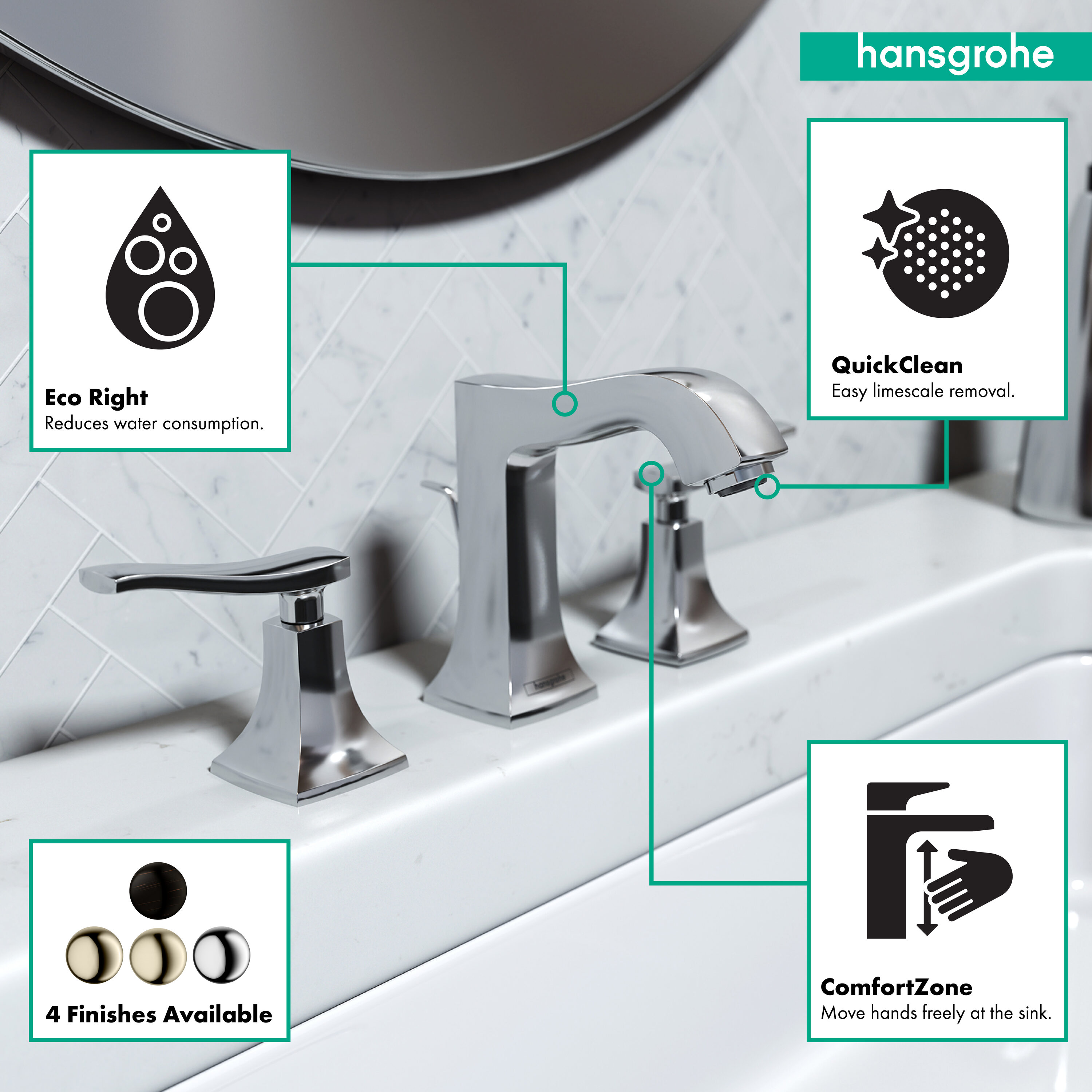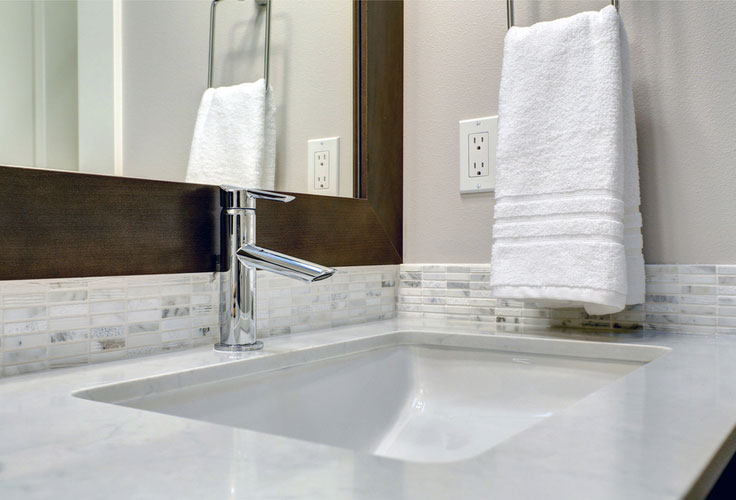To remove a Hansgrohe bathroom faucet handle, first shut off the water supply and remove the set screw securing the handle. A gentle pull will often free the handle from the mounting stem.
Removing a Hansgrohe bathroom faucet handle may seem daunting, but it’s a straightforward task that homeowners can tackle with a few basic tools. Whether you’re replacing the faucet, repairing a leak, or simply cleaning it, knowing how to take off the handle is essential.
It’s important to start by turning off the water supply to prevent any unexpected spills. Tools like an Allen wrench or a screwdriver might be needed to loosen the set screw that typically holds the handle in place. Once the technical part is taken care of, most handles come off with a simple tug. This process not only simplifies maintenance and repairs but also extends the life and performance of your Hansgrohe faucet.

Credit: www.amazon.com
Introduction To Hansgrohe Faucet Maintenance
Clear, flowing water is a tap turn away with Hansgrohe bathroom faucets. Maintenance is key to a well-functioning faucet. Quality faucets like Hansgrohe’s need attention to continue their blend of design and utility. Whether it’s a drip or a stiff handle, knowing how to maintain your faucet is essential. This piece will guide you on keeping your Hansgrohe faucet in top shape, starting with handle removal.
The Importance Of Regular Upkeep
Consistent maintenance ensures your faucet works smoothly. A faucet without regular upkeep can lead to buildup and leaks. Regular care avoids costly repairs. Checking your Hansgrohe now can save time later.
- Prevents mineral buildup
- Stops leaks before they start
- Keeps water flow efficient and consistent
Identifying Your Hansgrohe Model
Hansgrohe offers a range of faucets. Each model might have unique features and components. Knowing your model helps with accurate maintenance. Look for the model number on your faucet. It’s often found on the back or the base.
Here’s what you might find:
| Model | Feature |
|---|---|
| Metro | Minimalist design |
| Talis | EcoSmart technology |
| Focus | ComfortZone heights |
Tools You Will Need
Removing a Hansgrohe bathroom faucet handle requires specific tools. Before starting, gather the right equipment to make the job smooth and efficient. Proper preparation ensures a successful removal.
Subheading: Essential Items for the JobEssential Items For The Job
Begin with the basics:
- Allen wrenches: To loosen set screws
- Adjustable wrench: For various nuts
- Slip-joint pliers: To grip parts
- Flat-head screwdriver: For prying caps
- Towel or cloth: To protect the finish
- Penetrating oil: If screws are stuck
Optional Tools For Troubleshooting
Encounter a hitch? These items can help:
- Plumber’s grease: For sticky fixtures
- Flashlight: To illuminate work areas
- Multi-tool: For unexpected challenges
Step-by-step Handle Removal
Upgrading your bathroom’s look starts with small changes, like removing an old faucet handle. Whether you’re a DIY beginner or a seasoned pro, these simple steps will guide you through the process. Prepare to give your bathroom a fresh new look with our step-by-step handle removal instructions. Follow each step carefully for a smooth removal.
Shutting Off The Water Supply
Start by cutting off the water, which is vital to prevent flooding. Locate the valves under the sink. These are your water supply lines. Twist them clockwise to turn off. You should do this for both the hot and cold water lines. After shutting off, open the faucet to release any pressure and drain remaining water from the lines. Keep a towel handy for any drips.
Dismantling The Handle
- Begin by finding the set screw that holds the handle in place. You’ll typically find this hidden under a decorative cap on the handle’s top or at its side.
- Use a small flathead screwdriver to pry off the cap gently. Be cautious to avoid scratching the finish.
- Once the cap is removed, use an Allen wrench or a Phillips-head screwdriver to turn the set screw counterclockwise. This will detach it from the mounting stem.
- Pull the handle away from the faucet’s body. If it’s stuck, wiggle it gently back and forth until it loosens.
- If you encounter any resistance, use a handle puller – a tool designed to remove stubborn handles without causing damage.
After you’ve successfully removed the handle, you’ll have clear access to the inner workings of your faucet. From here, you can proceed to fix leaks, replace parts, or install a brand-new handle to refresh your faucet’s appearance.
Troubleshooting Common Issues
Troubleshooting common issues with a Hansgrohe bathroom faucet handle can often feel daunting. Fear not, with the right tips, you can quickly solve most problems. Whether it’s a handle that won’t budge or has succumbed to the test of time with wear and corrosion, there are straightforward fixes you can apply. Let’s delve into these troubles and find the solutions.
Dealing With A Stuck Handle
A handle that won’t move can be frustrating. First, ensure the water supply is off. Grip the handle firmly and wiggle gently to loosen it. Sometimes, a penetrating oil can work wonders.
- Turn off water from the mains
- Apply penetrating oil around the handle base
- Wait a few minutes
- Attempt to wiggle the handle gently
If the handle remains stuck, a handle puller tool might be needed. Avoid excessive force to prevent damage.
Addressing Wear And Corrosion
Over time, handles can wear down or corrode which affects their performance. Recognize signs of wear and corrosion, such as discoloration or flaking material.
- Clean the handle with a mixture of white vinegar and water
- Use a soft-bristled brush for stubborn areas
- Rinse and dry thoroughly
- Inspect for damage that might need professional attention
For minor issues, a thorough cleaning may restore function. Regular maintenance helps prevent future problems.
Finishing Up: Reassembly And Testing
With the Hansgrohe faucet handle now removed, it’s time for the final steps. Proper reassembly and testing ensure no leaks and a smooth operation. This guide will walk you through these critical stages with ease. Let’s get that faucet back in top shape!
Reattaching The Handle
Reattaching the faucet handle is straightforward. Follow these steps and your handle will be as good as new:
- Position the handle on the stem.
- Secure it with the screw you set aside earlier.
- Use a screwdriver to tighten, but be gentle to avoid stripping.
- Place the cap or button back on top to conceal the screw.
Make sure everything aligns and sits snugly.
Ensuring Proper Functionality
Follow these checks to ensure your faucet handle works perfectly:
- Turn on the water supply.
- Operate the handle and observe the water flow.
Listen for smooth operation, with no squeaks or stiffness. Check for any drips or leaks at the base. If all is clear, you’ve successfully reassembled your Hansgrohe faucet handle!
Required to pass validation for empty paragraphs. Please keep this line even if it looks unnecessary.
Credit: www.lowes.com

Credit: www.lowes.com
Frequently Asked Questions On Hansgrohe Bathroom Faucet Handle Removal Tips
How To Detach A Hansgrohe Faucet Handle?
Removing a Hansgrohe faucet handle often requires an Allen wrench to loosen the set screw, typically found on the handle’s underside.
What Tools Are Needed For Hansgrohe Handle Removal?
You’ll need a flathead screwdriver, an Allen wrench set, and sometimes pliers for Hansgrohe faucet handle removal.
Are Hansgrohe Faucet Handles Screw Or Snap-on?
Hansgrohe faucet handles are generally secured by screws, commonly with an Allen wrench set screw.
Can I Replace A Hansgrohe Faucet Handle Myself?
Yes, replacing a Hansgrohe faucet handle is a doable DIY task with the right tools and instructions.
Where Is The Set Screw On My Hansgrohe Faucet?
The set screw for a Hansgrohe faucet is usually located under the lever or cap at the base of the handle.
Conclusion
Removing the handle from your Hansgrohe bathroom faucet can be a breeze with the right approach. Keep tools handy and follow the steps closely for a successful handle removal. For further assistance, consult Hansgrohe’s customer support or a professional plumber.
Refresh your bathroom’s look effortlessly by starting with the simplest details—your faucet handles.





Leave a Reply